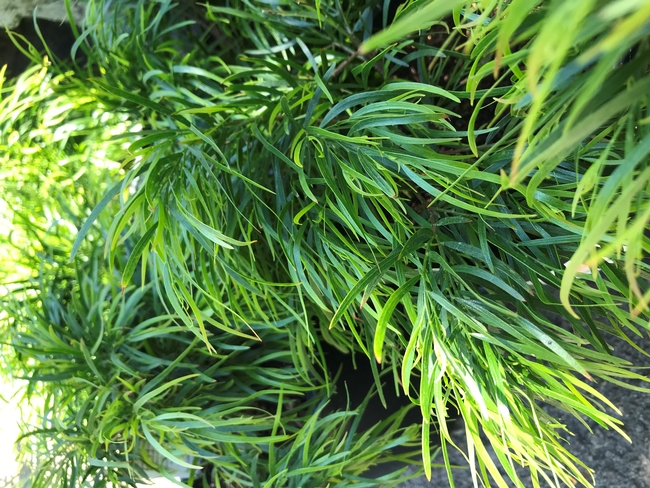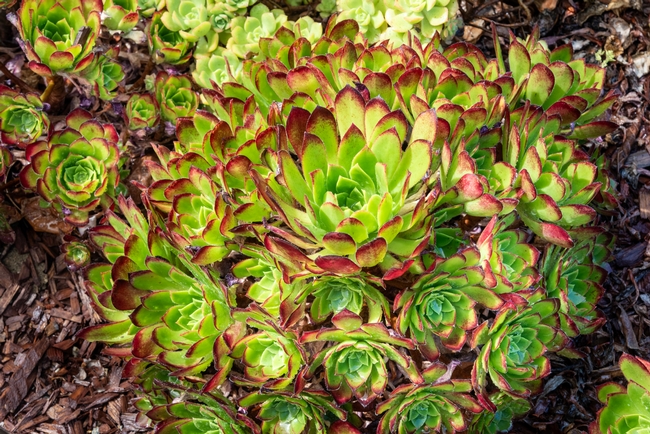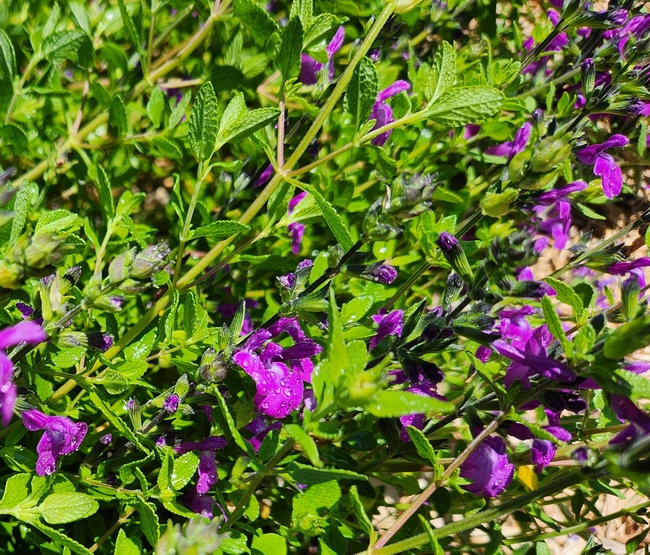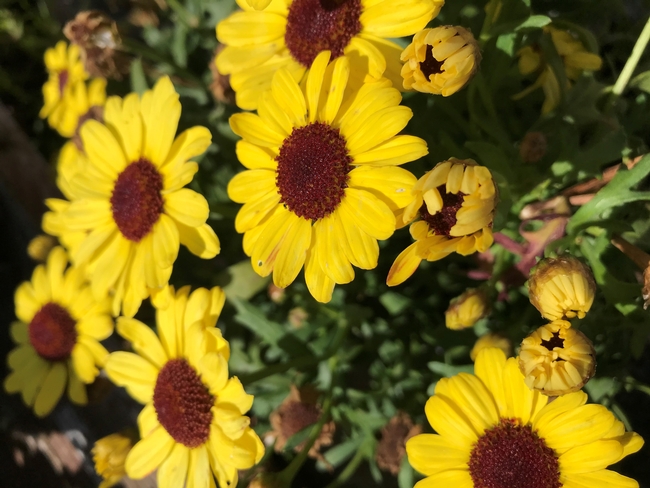- Author: Deborah Light-Pacheco
- Editor: Noni Todd
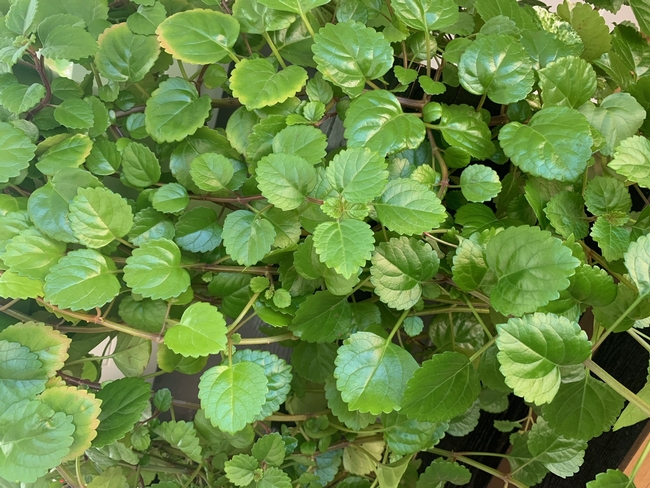
Creeping Charlie
By Deborah Light-Pacheco UCCE Master Gardener
Common name of plant: Creeping Charlie or Swedish Ivy
Scientific name: Plectranthus verticillatus
Planting area: Sunset 22-24: H2; or indoors
Size: 4-8 inches tall, 4-6 inches wide
Bloom Season: intermittently
Exposure: partial shade, bright indirect light
Pruning needs: as needed
Water needs: Regular
Growing up I fell in love with houseplants. There were so many varieties, and they were so festive and fresh. My favorite was, and still is, the houseplant variety of Creeping Charlie. Creeping Charlie is related to coleus and are native to tropical regions. Different varieties have different leaf colors, but he houseplant variety has roundish, waxy dark green and scalloped edged leaves that smell uniquely fresh and spicy at the same time. This perennial is a member of the mint family. And as such, the aromatic nature of the plant lends itself for use in essential oils, anti-fungal and anti-bacterial medicinals. Charlies look glamorous in hanging baskets or in decorative pots. The P. verticillatus variety produces white or pale purple blossoms intermittently all year.
A fun fact is that President Kennedy was gifted a Swedish Ivy plant from the Irish Ambassador during his term of office. An offspring of the plant still exists in the White House and can be seen in photographs above the mantel of the fireplace. Rumor has it this is the most photographed plant in the world!
Though this specific variety of Creeping Charlie is a houseplant, it can be used outside as ground cover in a warm protected area. The plant can grow from 4-8 inches high and 4-6 inches wide. Whether grown as a houseplant or outdoor ground cover, this plant is easily propagated by cuttings. The stems root easily in the ground or in water. The only soil they don't appreciate is a heavy clay. If planting within a pot, peat based potting soil is best. Water to maintain a moist, but not wet, soil. Pinch it back regularly to maintain the plant's shrubbiness. Charlies need approximately 6 hours of filtered bright sunlight per day. The two most important factors in your houseplant's health are the right amount of light and the right amount of water. Your Creeping Charlie will creep into your heart and become your favorite with the right care. Enjoy!
Advice to Grow By Workshops
Our next San Luis Obispo Advice to Grow By Workshop will be January 21st, 2024. The subject will be “Fruit trees-How Winter Care Can Aid Warm Weather Success”. More information to follow.
You can view workshops on Instagram live at slo mg or visit our You Tube channel at “San Luis Obispo County UC Master Gardeners.”
Visit our website at ucanr.edu/sites/mgslo/ or email questions to anrmgslo@ucanr.edu.
UCCE Master Gardener Helpline offices:
San Luis Obispo: 805-781-5939 (Monday and Thursday 1:00 to 5:00)
Arroyo Grande: 805-473-7190 (Wednesday 10:00 to 12:00)
Templeton: 805-434-4105 (Wednesday 9:00 to 12:00)
- Author: Andrea Peck
- Editor: Noni Todd
Cousin Itt Acacia
By Andrea Peck UCCE Master Gardener
Common name of plant: 'Cousin Itt' Acacia
Scientific name: Acacia cognata
Planting area: USDA Zones 9-11
Size: 3' tall x 3' wide
Growth season: Evergreen
Exposure: Full to partial sun
Pruning needs: Low
Water needs: Low
Snapshot:
No need for Halloween décor this year---not if you have the Cousin Itt Acacia, that is. Cousin Itt lives up to his name and reputation. You may catch yourself staring at Itt wondering exactly what you're looking at---is it a grass, a tree, a bush? Put a hat and glasses on your mystery plant and you may trick your friends into believing Cousin is just another guest. We do know, however, that underneath that mass of green cascading foliage are actual roots.
Though it's hard to determine if this plant is standing or laying down, Cousin Itt makes a nice addition to any garden setting. You'll be won over by the quiet grace of the weeping growth habit and the shine of the blue-green leaves. Itt is often utilized in difficult areas such as sloped spaces or dry creek beds. Native to Australia, Cousin Itt is well-versed in drought-speak and once established, Itt handles dry weather with aplomb---though it will be hard to tell by its expression.
During the first year, it is important to provide regular irrigation in well-draining soil. Slightly acidic soil enriched with organic matter is preferred. After the roots have made themselves at home, your dear Cousin won't ask for much. This plant will spread to a contained three-feet tall by three-feet wide and only require pruning when a branch is damaged. Avoid over pruning as it may lead to a haystack look.
When spring rolls around, feed your favorite Cousin a general all-purpose fertilizer as needed, following label instructions. Itt will have a growth spurt during this time and will appreciate the added nutrition. As summer looms, your little Itt will continue to grow, making itself more comfortable each day. Some even say they've seen Cousin Itt shuffling around amongst the plants, whispering gibberish into the night air. But that couldn't happen, could it?
Advice to Grow By Workshops
Our next San Luis Obispo Advice to Grow By Workshop will be January 21st, 2024. The subject will be “Fruit trees-How Winter Care Can Aid Warm Weather Success”. More information to follow.
You can view workshops on Instagram live at slo mg or visit our You Tube channel at “San Luis Obispo County UC Master Gardeners.”
Visit our website at ucanr.edu/sites/mgslo/ or email questions to anrmgslo@ucanr.edu.
UCCE Master Gardener Helpline offices:
San Luis Obispo: 805-781-5939 (Monday and Thursday 1:00 to 5:00)
Arroyo Grande: 805-473-7190 (Wednesday 10:00 to 12:00)
Templeton: 805-434-4105 (Wednesday 9:00 to 12:00)
- Author: Samantha Dowdall
- Editor: Noni Todd
Jack Catlin
By Samantha Dowdall UCCE Master Gardener
Common name: Aeonium ‘Jack Catlin'
Scientific name: Aeonium canariense
Planting Area: USDA zones 9b -11
Size: Each rosette can grow to 6-8 inches across, and individual plants can spread to 18” tall and 24” wide.
Bloom Season: Aeoniums are cool weather growers, producing bright yellow flowers in the winter here along the Central Coast. Unlike most aeoniums, ‘Jack Catlin' rosettes do not die after blooming. During the warm months it will become mostly dormant, then resume growth beginning in autumn.
Exposure: Full to part sun
Pruning needs: Spent flowers can be removed to maintain a tidy appearance. While most aeoniums can be propagated by cuttings. Propagate by replanting the new growth pups once they have rooted and are still attached to the mother plant.
Water needs: Low to medium, depending on time of year. During particularly hot spells, twice weekly watering will keep your aeonium happy, otherwise once a week is sufficient.
Snapshot: Aeonium is a beautiful succulent originating in the Canary Islands off the coast of Spain. This striking specimen was developed at the renowned Huntington Botanical Garden by horticulturist Jack Catlin. It is a hybrid of A. arboretum ‘Zwartkop' and A. tabulforme, which produced a plant with large symmetrical rosettes, deeply cupped, with dark red outer leaves and an apple green center.
As with all succulents, aeoniums require well-draining soil. These plants do not like wet feet! If grown in pots with good drainage, a commercial cactus mix will provide the proper amount of moisture.
One of the wonderful characteristics of ‘Jack Catlin' is its greater tolerance for both heat and light frost than most aeoniums. This is good news for succulent lovers with gardens in the inland areas who have both warmer and colder seasons than along the coast.
With enough space, this vigorous grower will stretch into low drifts of brilliant color. Planted next to a bright green or yellow groundcover, such as Sedum ‘Fine Gold Leaf', ‘Jack Catlin' is a real show-stopper for your Mediterranean garden on the Central Coast!
Advice to Grow By Workshops
Our next San Luis Obispo Advice to Grow By Workshop will be October 21st, 2023, at 10:00 to 12:00 p.m. in our Garden of the Seven Sisters Demonstration Garden at 2154 Sierra Way, San Luis Obispo. The topic will be “Vertical Vegetable Gardening.” The workshop is free and open to the public. Docents will be available after the workshop until 1:00 pm. If inclement weather, the workshop will be canceled.
You can view workshops on Instagram live at slo mg or visit our You Tube channel at “San Luis Obispo County UC Master Gardeners.”
Visit our website at ucanr.edu/sites/mgslo/ or email questions to anrmgslo@ucanr.edu.
UCCE Master Gardener Helpline offices:
San Luis Obispo: 805-781-5939 (Monday and Thursday 1:00 to 5:00)
Arroyo Grande: 805-473-7190 (Wednesday 10:00 to 12:00)
Templeton: 805-434-4105 (Wednesday 9:00 to 12:00)
- Author: Polly Nelson
- Editor: Noni Todd
Sage
By Polly Nelson UCCE Master Gardener
Common name: Salvia or sage
Scientific name: Pictured is Salvia microphylla x chamaedroides ‘Christine Yeo'
Planting area: USDA 7-24
Size: This specific species, 12-18” tall, 3-4 feet wide
Bloom season: Mid-spring to late fall
Exposure: Full sun or part shade
Pruning needs: Deadhead to promote re-blooming.
Water needs: Moderate until established, then minimal; however, it blooms better with additional water in summer.
Snapshot: Salvias are rich in diversity and are perfect for our climate, as they can thrive in dry conditions. Salvias, also referred to as sages, are the largest genus within the Lamiaceae (mint) family. Salvia varieties are distinguished by characteristics including leaf size, color, texture, and shape; growth habit (mounding vs upright, for example); and flower shape and color. All Salvias do, however, have a squared stem just as all the other members of the mint family.
Two distinct Salvia species have merged to form the hybrid ‘Christine Yeo' (pictured). Salvia microphylla has dark green, oval tooth-edged leaves, with shades of red flowers. Salvia chamaedroides has narrow, half-inch, gray-green leaves with dark blue flowers. Both are native to northern Mexico.
Which brings us back to the pictured hybrid, ‘Christine Yeo', featuring bright green, textured, oval leaves on square stems and beautiful purple flowers. It reminds me of two parents producing a child with wonderfully blended characteristics!
Plant ‘Christine Yeo' in soil with good drainage. Soggy roots are prone to disease and will not withstand freezing winter temperatures. If soil is heavy, work in organic matter to improve drainage. Plant in full sun if your summer temperatures are mild. Otherwise, plant in partial shade. ‘Christine Yeo' is a mounding salvia whiles other varieties are upright or prostrate creepers. Give this mounding variety enough space to develop and spread. Water deeply once a month during summer until the plant is established. Do not fertilize, as excessive growth can weaken the plant, invite aphids, and promote root rot. Encourage new growth with a hard prune in late winter or early spring when weather is cool. Shape during the growing season by pinching stem tips or cutting back stems by no more than one-third.
Propagation is done by division or by taking softwood cuttings early spring from vigorous non-flowering shoots. Alternatively, you may also collect seeds from pods at the base of flower spikes.
Explore the many varieties of Salvias to add color and texture to your low maintenance landscape!
Advice to Grow By Workshops
Our next Advice to Grow By Workshop will be October 21st, 2023, at 10:00 to 12:00 p.m. in our Garden of the Seven Sisters Demonstration Garden at 2154 Sierra Way, San Luis Obispo. The topic will be “Vertical Vegetable Gardening.” The workshop is free and open to the public. Docents will be available after the workshop until 1:00 pm. If inclement weather, the workshop will be canceled.
You can view workshops on Instagram live at slo mg or visit our You Tube channel at “San Luis Obispo County UC Master Gardeners.”
Visit our website at ucanr.edu/sites/mgslo/ or email questions to anrmgslo@ucanr.edu.
UCCE Master Gardener Helpline offices:
San Luis Obispo: 805-781-5939 (Monday and Thursday 1:00 to 5:00)
Arroyo Grande: 805-473-7190 (Wednesday 10:00 to 12:00)
Templeton: 805-434-4105 (Wednesday 9:00 to 12:00)
- Author: Andrea Peck
- Editor: Noni Todd
Grandaisy Yellow
By Andrea Peck UCCE Master Gardener
Common name: Grandaisy Yellow
Scientific name: Argyranthemum frutescens
Planting area: USDA Zones 9-11
Size: 18-24”
Bloom Season: spring to summer
Exposure: full to partial sun
Pruning needs: to promote midseason bloom
Water needs: low
Snapshot:
If you're in the market for showstopping, Grandaisy Yellow is just the ticket. Large blooms, bright yellow petals, and a teddie bear brown center make this plant the highlight of any garden. Grandaisy gives you a boost in the morning, welcomes you in the evening, and word travels insect-speed as bees and butterflies fly like the crows to visit.
Yes, the Grandaisy is indeed Grand. A vigorous flowering plant, it grows up to two feet in width and height and blooms heavily in early spring---perfect timing as we shed the doldrums of winter. It grows best in temperatures that range between 60ºF and 70ºF. Depending on your location, plant in full sun or partial sun. The Grand Lady may fade in high temperatures, but as summer approaches, we want to keep this star of the show happy.
She is not picky, however, when it comes to the dirt beneath her feet. It won't be necessary to special order soil; just the basics will do. Perhaps the swooning blooms on her head, keep her mind off of her toes, but do make sure the soil drains well. Excess moisture around her roots may cause rot. Which leads to that important California question, to which we answer ---yes, Grandaisy is drought tolerant. Just make sure to irrigate the plant under very hot, dry conditions. Like other athletes, promote maximum performance by using a well-balanced, all-purpose liquid fertilizer once monthly. Pruning as blooms fade will encourage a second flowering.
This plant is equally comfortable potted or in the ground. But beware if you plant her en masse, you may cause a traffic jam as your neighbors slow down to ogle the display.
There's nothing better than a bright bushy plant with a head full of sunny yellow flowers. When the experts describe it with the word 'vigor', it's even better.
Advice to Grow By Workshops
Our next Advice to Grow By Workshop will be October 21st, 2023, at 10:00 to 12:00 p.m. in our Garden of the Seven Sisters Demonstration Garden at 2154 Sierra Way, San Luis Obispo. The topic will be “Vertical Vegetable Gardening.” The workshop is free and open to the public. Docents will be available after the workshop until 1:00 pm. If inclement weather, the workshop will be canceled.
You can view workshops on Instagram live at slo mg or visit our You Tube channel at “San Luis Obispo County UC Master Gardeners.”
Visit our website at ucanr.edu/sites/mgslo/ or email questions to anrmgslo@ucanr.edu.
UCCE Master Gardener Helpline offices:
San Luis Obispo: 805-781-5939 (Monday and Thursday 1:00 to 5:00)
Arroyo Grande: 805-473-7190 (Wednesday 10:00 to 12:00)
Templeton: 805-434-4105 (Wednesday 9:00 to 12:00)


